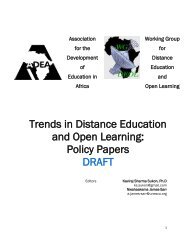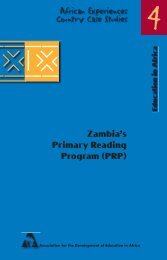Secondary EducationExpanding SecondaryEducation: HowCan It Be Financed?Estimates say that by 2015 three times as many students will be knocking at thedoors of secondary education as completed primary school in 2000. Countries mustbe prepared to meet this demand, which will have financial consequences and animpact on enrolment rates.In order to assess the financial sustainabilityof different patterns ofexpansion for secondary educationin sub-Saharan Africa, we need first tomake two broad sets of assumptions.One concerns available financing, thatis, the likely amount of national publicresources that could be mobilized at agiven time; and the other concerns totalcosts, which depend on the coverage ofthe system in this period and the level ofpublic spending per student.Available resourcesGiven the low fiscal base (publicrevenues represent between 8 and16% of GDP in most countries) andthe keen competition from all sectorson public resources, it is unlikely thatmany countries will be able to mobilizemore than 20% of their public domesticresources for education.Consequently, publicfunding for educationwill in most instancesrepresent less than4.0% of a country’s GDP.Besides, the indicativeframework suggests thathalf of it will be allocatedto primary education. In2001, general secondaryeducation received onaverage about 0.83% ofGDP while technical and higher education,along with preschool, receivedon average 0.94%. Since there willundoubtedly be continuing pressurefrom these sub-sectors to receive additionalresources, it will be difficult toincrease the amount of public spendingAssuming that universalprimary school completion isreached in 2015, for manycountries even to maintainthe present transition ratesfrom primary to secondary isa considerable challenge.for general secondary education as ashare of GDP.A range of expansion modelsExpansion of secondary education maymean very different things in differentcountries. For example, the GER for lowersecondary education for low-incomeAfrican countries is on average 30.5%but it is below 15% in Niger, Burundiand Chad, around 30% in Benin, Côted’Ivoire or Senegal, and above 60% inGhana, Togo or Zimbabwe.The different targets that countriesmay set for coverage of secondary educationin 2015, for example, will havevery different consequences accordingto choices made. Many policy optionsare possible, but we will limit ourselvesto just three: Scenario 1: assumes that accessto lower secondarybecomes universal in2015 and that the transitionrate between thetwo cycles of secondaryeducation remainsat its 2001 level.Scenario 2: merelytries to maintain thetransition rates – bothbetween primary andsecondary educationand between the two cycles ofsecondary education – at their 2001level.Scenario 3: is based on the sameenrolment pattern as scenario 2but anticipates about a one-thirdreduction of unit costs for secondaryeducation.In weighing the consequences it isimportant also to consider the type ofsecondary education envisioned andits unit cost.Secondary education costs aboutthree times as much as primary educationdue to lower pupil teacher ratios andhigher levels of teacher remuneration.The average unit costs are estimated atabout 12 and 38% of the per capita GDP.Nevertheless, per student spending varieswidely from country to country. Forexample, in lower secondary, unit costsvary from 13 to 64% of per capita GDP(from 1 to 5), while at upper secondarylevel it ranges from 22 to 157% of percapita GDP (this is from 1 to 7). It istherefore important to understand thereasons behind the variations in order toidentify to what extent they correspondto variations in quality, in content, or incost and efficiency.How sustainable arethe different models?In assessing the sustainability of the differentmodels, the following assumptionswere made:About public resources: the costingsbelow provide an estimate ofresources needed to reach EFA by2015 and what is left after 50% isused for primary education. Fromthe remaining 50% we have subtractedthe same proportion of GDPgoing to preschool, vocational andhigher education. We thus arrive atthe amount of public resources thatcould reasonably be made availablefor general secondary education.About spending: we have estimatedcosts for scenarios 1 and 2 describedabove (see “A range of expansionmodels”). Both these models arebased on the assumption that allcountries are to achieve universalprimary completion by 2015. Asfor unit costs, the first assumes perstudent spending (in per capita GDPterms) in both cycles of secondarywill remain in each country as in2001; the second factors in a unitcost reduction of about 30% if variousinefficiencies were eliminated.We have in hand fairly up to dateeducation finance simulation modelsfor the whole sector for a sampleof ten countries: Benin, Cameroon,Madagascar, Mali, Mauritania,14 <strong>ADEA</strong> <strong>Newsletter</strong> July - September 2004
Mozambique, Niger, Rwanda, Senegaland Togo.The results appear in the table below.The first two lines provide data on thecost and financing figures for primaryeducation in the 10 countries, using theparameters of the Fast-Track Initiative.They offer some idea of the magnitude ofthe effort required to achieve the targetassumed for the development of secondaryeducation.Scenario 1, the most ambitious,which foresees a 100% transition fromprimary to secondary, would requirespending an estimated US $ 3.0 billion in2015, leaving a financing gap of US $ 2.5billion. This is about 4 times the amountof foreign aid required to help thesecountries achieve universal primarycompletion in 2015. Without externalaid, these countries would have to useon average 44% of their public domesticresources to cover the costs.Scenario 2, which is a little less ambitiousbecause it assumes that transitionrates from primary to secondary aremaintained at 2001 levels, is much lesscostly. It would require US $1,291 millionin 2015, or about half that requiredin scenario 1. However, these costs arestill about twice as high as the requirementof the Fast-Track external fundingfor primary education.Scenario 3, is based on the samecoverage assumptions as scenario 2 butdiffers in the unit costsof secondary education,which are muchlower. The impact ofthis reduction is significantbecause the financinggap for 2015 dropsfrom US $1.2 billionwith scenario 2 to US$750. Even so, the gapis still substantial sinceit exceeds the amountof external fundingforeseen for financingprimary education.What can we concludefrom this? Assuming thatuniversal primaryschool completion isreached in 2015, formany countries evento maintain the presenttransition ratesfrom primary to secondaryis a considerablechallenge. Efficiency in servicedelivery is animportant elementto consider and anumber of countrieswill have to find ways to contain unitcosts without reducing the quality ofservice.The conditions vary substantiallyEstimates of Spending, Domestic Resources and Financing Gap in 2015 for Primaryand Secondary Education according to Alternative Assumptions for the Developmentof Secondary Education (million US $ of 2001 for the sample of 10 countries)Level of SchoolingTotal Domestic Financingand ScenarioSpending ResourcesGapPrimary EducationRecurrent (million US $ of 2001)according to Fast-1766 1049 636Track parameters Capital (million US $ of 2001) 215 0 215General 1 Primary-Secondary Transition Recurrent (million US $ of 3039 498 2541SecondaryEducationRate = 100 % in 2015Lower-Upper Secondary Transition2001)% of public resources for - 44% 0Rate = 2001Unit cost = 2001the sector necessary toclose the recurrent gap withdomestic resourcesCapital (million US $ of 307 0 3072 Primary-Secondary TransitionRate = 2001Lower-Upper Secondary TransitionRate = 2001Unit cost = 20013 Primary-Secondary TransitionRate = 2001Lower-Upper Secondary TransitionRate = 2001Unit cost = lower third of thedistribution of 20012001)Recurrent (million US $ of2001)Recurrent (million US $ of2001)Source: Table from "Summary"* Benin, Cameroon, Madagascar, Mali, Mauritania, Mozambique, Niger, Rwanda, Senegal, Togo.1789 498 12911248 498 750across countries. Therefore, it will benecessary to mobilize the relevantdocumentation for all of them, toincrease awareness of the magnitudeof the challenge ahead, and toenter a well documented policydialogue. It is urgent that thedevelopment partners enterinto a constructive policy dialoguewith governments to helpthem address the many serioussocial, financial, economic andequity issues that demand pressureson secondary educationare likely to create.▼1. Article based on Alain Mingat’spaper “Issues of financialsustainability in the developmentof secondary education in Africa(SEIA)," presented at the SEIA donorconference at the Vrije UniversiteitAmsterdam, Netherlands, in October2004.The full text is available at:http://www.worldbank.org/afr/seia/donors_meet_10_04.htm<strong>ADEA</strong> <strong>Newsletter</strong> July - September 200415
















